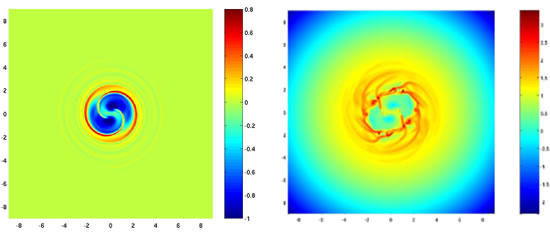研究成果藝廊 > 理論天文物理理論天文物理
(Theory)
研究成果藝廊
理論天文物理理論天文物理
(Theory)
| Evolution and Instability of a Self-gravitating Galactic Gaseous Disk under the Influence of a Fast Rotating Bar Potential |
|
圖片來源: Chi Yuan and David C.C. Yen

Surface density for single OLR. Spiral waves are excited at 2kpc by a fast bar potential, lying in the horizontal direction. The high density spiral regions would lead to starbust activities as shown in the right panel is when the self-gravity of the disk is introduced.
|
| OLR and Starburst Rings: We use the Elmegreen rotation curve and a fast rotating bar such that only OLR exists. With pattern speed Omega_p=140km/s, the OLR occurs at r=2k pc. The result is a pair of tightly wound spirals being generated at the OLR with no central features present, exactly as the asymptotic theory predicts. Since at OLR, the bar transport angular momentum to the disk. The disk mateiral near the resonance gains angular momentum and move out. It evantually clear a gap behind it. Inside the spiral-ring is a wide region void of gas. However, when self-gravity of the disk is included, the spirals become unstable and develop into chaos. This is because the rapid increase of surface density, in the narrow spiral-ring region forces the Toomre's variable Q there to go under 1 and thus turn that region into instability. (Chi Yuan and David C.C. Yen , 2005, JKAS, 38(2), 197-201) |
 asiaa.sinica.edu.tw 媒體連絡: epo
asiaa.sinica.edu.tw 媒體連絡: epo asiaa.sinica.edu.tw
asiaa.sinica.edu.tw